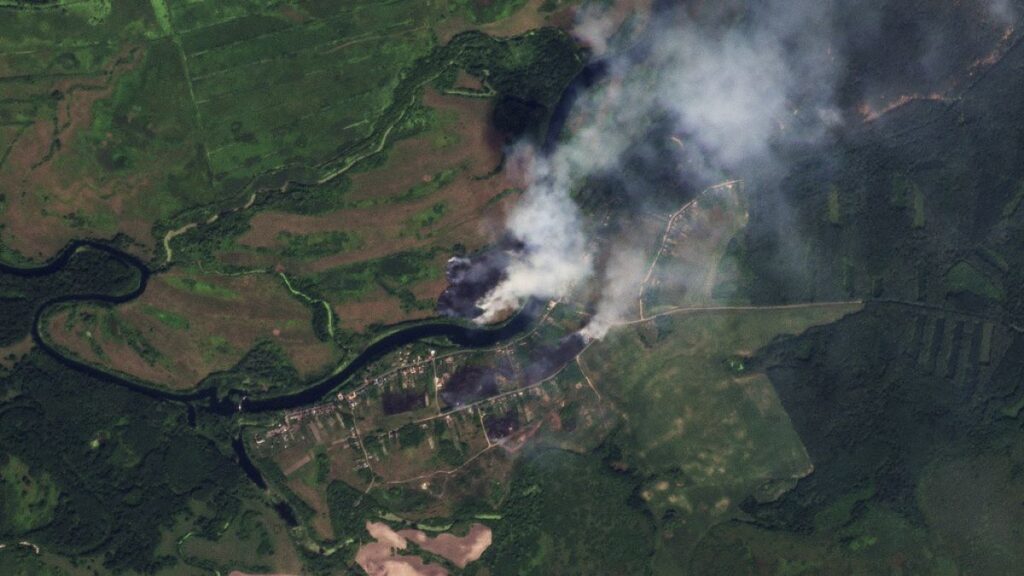An analyst at the Institute for the Study of War, a Washington-based think tank, told euronews in an interview that the surprise operation had demonstrated the vulnerabilities of Putin’s regime and would change the way Russian society perceives the war in Ukraine.
Two weeks after Kyiv’s surprise incursion into Russian territory, the situation on the ground seems to indicate that Ukrainian forces are not done yet.
When they have crossed the border between the Sumy region of Ukraine and the Kursk region of Russia on August 6many thought it would be another quick raid. The operation surprised civilians, observers, Ukraine’s Western allies and Russian authorities.
And it is this unprecedented operational security that has been the key to success, as this expert explains to us.
“And I think Ukraine has rightly learned from its experience in planning the counteroffensive last year, because they communicated a lot and informed a lot about it, which really allowed the West, but also Russia, to anticipate where Ukraine was going to attack and when,” Hird continues.
ISW: Kursk raid will expose Putin regime’s vulnerabilities
Even a brief shift in hostilities to Russian soil is “incredibly significant,” Hird said, and will have serious consequences and expose the vulnerabilities of Putin’s regime in “two months, three months, at the end of the year.”
“There are so many nuances that seem very recent today, but I think they will create discontent (in Russia) in the long run. The use of conscripts, for example, and more generally, the idea that the Russian border is not impermeable, that it is actually a vulnerability and that Russian society needs to start seeing it as such. I think it will change a lot of things in the way Russian society perceives the war and will show us, in a way, how the war can be perceived by Russian populists, who have been largely apathetic about it in the past.”
Zelensky at the border where the incursion started
Ukrainian President Volodymyr Zelensky on Thursday visited for the first time the border area where his forces launched their surprise offensive into Russia. He said Kyiv’s military had taken control of another Russian village and captured more prisoners of war.
In the Sumy region of northern Ukraine, Zelensky said new prisoners of war from Russia’s Kursk region would be contributed to the creation of an “exchange fund” to exchange them for captured Ukrainians.
“Another municipality in the Kursk region is now under Ukrainian control, and we have replenished the exchange fund,” Zelensky wrote on X after hearing a report from his country’s top military commander, Colonel-General Oleksandr Syrsky.
Mr Zelensky did not name the newly captured village and did not cross the border into Russia, which Moscow would have seen as a provocation. He has previously said that Ukraine does not intend to occupy the region in the long term, but wants to create a buffer zone to prevent further attacks from there into Ukraine.
Mr Zelensky said the Kursk operation, launched on August 6, had already helped reduce Russian shelling and civilian casualties in the Sumy region.
In another example of the intensification of Ukrainian attacks against Russia, emergency authorities in the Russian Krasnodar region said that:A Ukrainian strike hit a ferry loaded with fuel tanks in the port of Kavkazcausing a fire. This port is located in the Kerch Strait, which connects the Black Sea to the Sea of Azov.
The audacious Ukrainian incursion has rattled the Kremlin, exposing Russia’s vulnerability and undermining President Vladimir Putin’s efforts to pretend the country has been largely spared from the two-and-a-half-year war.
Ukraine’s push towards Russia marks the first capture of Russian territory since World War IIbut it comes as Kyiv continues to lose ground in eastern Ukraine.
Additional sources • adaptation: Serge Duchêne

